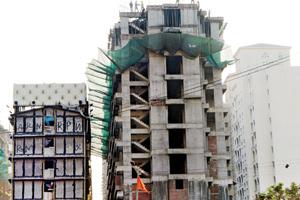Mumbai needs to learn from its history of bad planning, and correct its present for a safer future


Why did MHADA and BMC not assess the extra burden that new housing would have on the existing infrastructure? Representational Image
ADVERTISEMENT
 Mumbai is fiercely debating its new Development Plan. There is a vertical split in opinions. While proponents see it as a game-changer, a large section of people, including town planning experts, is sceptical about the document that will allow much taller buildings across the city, with a specific focus on island city, where old buildings need to be demolished for creating bigger, better and more homes.
Mumbai is fiercely debating its new Development Plan. There is a vertical split in opinions. While proponents see it as a game-changer, a large section of people, including town planning experts, is sceptical about the document that will allow much taller buildings across the city, with a specific focus on island city, where old buildings need to be demolished for creating bigger, better and more homes.
Parts of no-development zone lands will be freed for housing. Private land parcels where construction was barred earlier will now be exploited commercially, with a rider that developers will have to create a specific number of affordable housing units that the BMC will allocate to the needy at a reasonable rate through lucky draws.
Sounds promising? Yes, it does, but only on paper. You realise what a deep mess civic planners, developers (private or state, like MHADA) and all other agencies have created for you, only when you actually start living in these housing schemes. You realise soon that you have bought a basket of unending trouble with your hard-earned money.
The island city and suburbs have so many identical stories that are the outcome of unplanned development, one of which - Sion-Koliwada, Pratiksha Nagar-Wadala - is my locality since 2009. Journalists seldom write about themselves, but since this impacts several lakh residents, I'm presenting this as a case study of failed planning by the same people who are promising us wonders in the new DP, which will open up salt pan land, transit camps, the slums that have been eating into the eco-sensitive swamp near the east coast and old buildings, for development.
Contrasted with unauthorised shanties and affordable MHADA housing is MMRDA's 'dream' of creating another BKC at its Wadala land, part of which has a monorail depot, the RTO and a private housing complex, which is touted as a revised form of a SoBo locality.
The Eastern Express Highway runs very close to another housing complex in which former ministers, legislators and bureaucrats have availed of flats in the CM quota. Opposite this complex stands another huge slum that has been eating into the expanse of a beautiful talao (pond). Who cares when encroachment is first ignored and then protected by the people in power?
When MHADA took up Pratiksha Nagar's redevelopment, it built dozens of multi-storey buildings, including some skyscrapers. Many more have been planned. Why did they (MHADA and BMC) not assess the extra burden that new housing would have on the existing infrastructure? Clogged drains spill over the only narrow road that serves all MHADA complexes, one of which houses senior judicial officials. Of late, BMC is reworking underground drains, but people say this work got approval because of a by-poll in one of the affected wards. The only road sans pavement is authoritatively encroached upon by shops, vegetable vendors, shakhas and temples. Walking on it invites accident, because it is also used as a two-way by the hundreds of BEST buses that originate from Pratiksha Nagar depot.
With no stormwater drains, monsoons mean flooding for days together. Power outages are frequent because the existing cables and transformers don't match the increased consumption of electricity. Water supply is another concern. Healthcare and education are available in the vicinity, but quick access to these facilities may still be a problem because of traffic woes.
Another much-encroached road running under the Monorail track leads us to MMRDA's dreamland, where Metro's dusty casting yards work overtime. Every hour, slum dwellers in the neighbourhood breach a compound wall that stands between them and a much cleaner Monorail road for defecating in open in the nullah that carries the toilet waste from our buildings as well. The nullah serves thousands of people on its way to the creek.
In a small corner of our locality, where once stood a sedate single-storey chawl, a private developer has now built a 20-odd storey building as a rehab component. A sellable component will be built on a major portion of the land acquired for redevelopment. Where will their waste go? In the same nullah that carries others' untreated waste. The same nullah will work for a fancy housing complex on the MMRDA land.
The point I'm trying to make here is inadequacy of infrastructure that unplanned development creates, if not addressed in the early stages, ultimately leads to subhuman living conditions. It is a representative of woes affecting every class of citizens finding it difficult to get relief. The concerns that the new DP raises aren't any different from the existing ones. Ignoring the past and present would aggravate the situation further and turn a boom city into a doom city.
Dharmendra Jore is political editor, mid-day. He tweets @dharmendrajore Send your feedback to mailbag@mid-day.com
Catch up on all the latest Mumbai news, crime news, current affairs, and also a complete guide on Mumbai from food to things to do and events across the city here. Also download the new mid-day Android and iOS apps to get latest updates
 Subscribe today by clicking the link and stay updated with the latest news!" Click here!
Subscribe today by clicking the link and stay updated with the latest news!" Click here!






